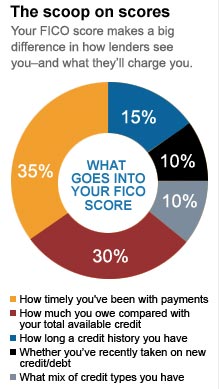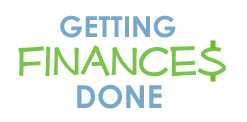Archive for August, 2009
How Your Credit Score Is Calculated
Written by Sam on August 31, 2009 – 9:23 am -There’s been a lot of talk in the news lately about credit card companies making changes, such as lowering credit lines and cancelling unused cards, that can lower credit scores even for responsible borrowers. In a recent post How to save your credit score I complained that credit scores seem to be such a mystical thing. I almost always hear broad generalities about how to improve your score, but rarely hear specifics.
Today that changed.
An article from CNNMoney.com (via Yahoo!) helped to clear up some of the confusion. The article actually breaks down how a credit score is calculated. Here’s a graph from the article:

It wasn’t clear to me if this graph covers ALL the factors in calculating a credit score, but it probably represents the most important factors. One clarification CNNMoney makes is that you should keep your debt utilization ratio under 10% if possible. It should never go higher than 20%.
I encourage you to read the whole article, but here is a summary of the most important factors in how your credit score is calculated and what you should do to keep your score healthy.
- Don’t make late payments (specifically over 30 days late).
- Keep your debt utilization ratio at ideally under 10% and certainly no more than 20%. This applies to any given credit account as well as looking at your debt for all accounts.
- Try to occaisionally use older credit cards so they don’t close the account on you. Older credit carries a greater positive weight in calculating your score.
- Opening new credit accounts tends to lower your score. Still no specifics on how much it lowers your score.
- The type of credit account you open has an affect on your score. While the CNNMoney article didn’t mention specifics, we know from my previous post that you should try to avoid opening accounts for retail and gas credit cards.
The article also listed a couple of resources that I haven’t had a chance to thoroughly check out, but that look useful.
Card Ratings.com
CreditKarma.com
Tags: credit rating, Credit Score, FICO
Posted in Credit Cards, Credit Ratings, Credit Score | Comments Off on How Your Credit Score Is Calculated
Get Free Books From PaperBackSwap.com
Written by Sam on August 28, 2009 – 11:08 am -
I recently learned about the site PaperBackSwap.com that allows you to swap books with others via mail. They have a nice system with some checks and balances that facilitate trust and honesty between traders. The site works on a credit system. When you sign up, if you immediately list 10 books you’re willing to trade, they give you 2 credits. Each credit allows you to receive one book. Audio books can also be traded and require 2 credits to receive. Every time you send a book you get a credit. You’re basically trading a book for a book.
How does the shipping part work? Once someone requests one of your books you have two options. The first option is to go to the post office and send the book. Once the person receives the book, they login to the site and mark it as received and you get your credit. The second option is to use PaperBackSwap’s built in system to pay for the postage and print out the needed labels at home. Using this system allows you to avoid a trip to the post office since you can just drop the book in your mailbox. Using this system also gives you your credit immediately so you don’t have to wait for the person receiving the book to mark it as received to get your credit. There’s a small additional fee to use this service, but it’s typically less than a dollar and probably cheaper than paying for the gas to go to the post office.
So far I’ve sent three books and have yet to request any. The selection of books posted looks decent, but not overly comprehensive. I found a few books I was interested in. If a book you want isn’t listed as available, you can reserve a copy and once someone has one available, you’ll be notified. The jury is still out for me on this site. I’ve spent an average of about $3.00 per book for each book I’ve sent. That’s less that half the price of buying a book new so if I end up getting some books I want through the service, I’ll consider it a success. If nothing else, it’s good to get rid of some books I no longer needs and reduce my clutter.
PaperBackSwap also has two sister sites; one for trading CDs and one for trading DVDs. I haven’t looked at them closely yet, but assume they work on the same system. If you want to refresh your collections, take a look.
Have any readers used these services? Let us know how you liked them in the comments.
Tags: books, Saving, Shopping
Posted in Saving, Shopping | Comments Off on Get Free Books From PaperBackSwap.com
How To Save Your Credit Score
Written by Sam on August 27, 2009 – 9:30 am -Real Simple recently published an article entitled “8 Surprising Ways to Save Your Credit Score.” Despite my best efforts to understand how credit scores are calculated, I still seem to hear conflicting information all the time. This article helped to provide me some clarity.
The most interesting point for me was the fact that many credit card issuers are closing accounts that haven’t had any activity for a while. If these accounts get closed, the article points out, it could have a negative impact on your credit score. That’s because it would cause your utilization ratio, the amount of debt you have incurred compared to the open credit available to you, to go down which could cause your credit score to decrease. It would cause a similar affect to a credit card issuer decreasing your credit limit, which apparently happened to several million credit card holders fairly recently and which I wrote about just last week (see Credit Card Companies Adjust Limits: Credit Ratings May Be Affected. Frankly, I’ve tried to shut down some old credit card accounts before, yet they keep showing up on my credit reports. I’d be happy if they shut them down.
A couple of the points in this article didn’t explain at all how they affect your credit score. For example point #2 talks about paying off your lowest balance credit cards first. While this is a solid debt re-payment strategy, how does it affect your credit score? Point #3 says that sometimes it can be worth it to use a credit card with an annual fee. Ok, and how does that affect your credit score?
Here’s one of the seemingly conflicting pieces of advice. You want to have many open credit card accounts to increase the amount of unused credit available to you, yet opening up a retail or gas credit account actually counts against you when calculating a credit score. So I guess you don’t just want any credit lines.
If you don’t want to take the time to read the article, here are a few general take-aways:
- Having available, unused credit has a generally positive impact on your credit score, unless the credit comes from retail or gas cards.
- Using your credit cards occasionally will help keep your accounts from closing and maintain a high utilization ratio, which is a good thing for your credit score.
- Consolidating multiple cards to one card can be risky if you come close to maxing out the card. Apparently that doesn’t look so good to the credit reporting agencies although the article doesn’t mention how close to the max is too close.
- The length of time you’ve had a credit card account can help to increase your credit score. The longer the better. So I guess I shouldn’t want to close those old unused accounts after all.
- Try not to max out your limits on one card. Instead, it’s better to charge a little on multiple cards. Apparently the credit bureaus calculate your utilization ratio on each individual card. This is a squishy one and there are no recommended limits to stay within.
Tags: Credit Cards, Credit Score
Posted in Credit Cards, Credit Score | 1 Comment »
How to Create a Financial Binder
Written by Sam on August 26, 2009 – 9:30 am -
It’s a common worry. Am I spending more than I should? When are my bills due? Have I paid them? Am I on track to reach my financial goals? Am I going to be able to get out (or stay out) of debt? Financial worries are not only one of the greatest causes of personal anxiety; they can also be one of the biggest strains on a relationship.
Many people don’t have their finances well organized and therefore aren’t able to tell where they stand. Disorganized finances can have severe consequences; In the short-term, you may end up paying hundreds of dollars in late fees and penalties. You may be digging yourself deeper into debt without even realizing it. In the long-term you won’t meet your high-level financial goals. Couples often end up re-hashing the same financial issues over and over again because they don’t have a way of tracking the decisions and progress they’ve made as a result of their arguments…er discussions. If your finances are not organized how can you ever have any hope of getting them under control?
The good news is that by taking one simple step you can start down the road of financial security and begin to get your finances in order. You can get a good overall view of your financial picture and establish a base from which you can build your financial future. It all starts with creating your financial binder.
What is a financial binder?
A financial binder is a place to keep all of your high-level financial information including important decisions and goals you’ve made. Instead of containing transaction-level, detailed information about your finances, it is a place for summary-level information about such things as bank accounts, bills, financial decisions, savings goals, taxes, and credit reports.
Your financial binder doesn’t necessarily have to be a binder. Any form of organizing papers into categories could technically work. However, there are certain advantages to using a binder.
- Binders are easy to expand. You can always add more tabs or upgrade to a larger binder (up to 5 inches).
- Binders are easy to customize. You will inevitably want to create categories and information unique to your situation.
- A Binder keeps items in one place and prevents them from getting misplaced.
- Binders are portable. My wife and I sometimes like to review our financial progress during quarterly getaways. Being able to take our binder and go makes it easy to conduct these remote reviews.
Paper vs. Digital systems
Many people ask why they shouldn’t keep their binder information in digital form. Although your binder is paper based, many of the contents may be created digitally. Simply take the last step of printing out the documents after you work on them and you’ll have a nice backup. Whenever you print a document, be sure to record both the date printed and the digital location of the file for later reference. While digital files do have advantages I discourage the use of exclusively digital storage for the following reasons.
- The “did I change this?” factor. By printing out a hard copy of digital files, you put a stake in the ground so to speak. You establish that “on this date, I made this decision” rather than second guessing if you’re looking at the most recent version of a document.
- Backup. If you haven’t had a hard drive crash on you yet, it’s just a matter of time. Most people don’t have adequate digital backup plans.
Here’s a handy tip: To make it easy to cross-reference your paper and digital files, alter your Microsoft Word or Excel settings to automatically print the date-printed and the digital location of each file. In either program, from the menu select “View — Header and Footer.” You can then configure exactly what you want to appear at the top and bottom of the page. You may have to play with this a little to get exactly the effect you want.
What should a financial binder contain?
Net Worth Statement
Ok, let’s get the big one out of the way first. Even though your net worth statement will probably only be less than a page long, it needs the most explanation. A net worth statement is the best way to track your overall financial progress in one quick view. It simply shows all of your assets minus all of your liabilities. If you’ve never created a net worth statement, don’t make it too complicated at first. Start with just the basics at first and you can make it more detailed over time.
Step 1.
List all of your assets, one per line, along with the value for each. For your first version, just list your bank accounts, investment accounts, and a rough estimation of how much your house is worth. If you have no idea how much your house is worth, just put down the amount you paid. Every time you update your statement, make an improvement – add the value of your cars, refine the calculation of the value of your home based on other houses for sale in your neighborhood, or start adding possessions that have significant value such as jewelry or electronics. Adding your possessions provides a nice side effect – it can act as a record for home owners insurance if items are damaged or stolen.
You can use online services to refine the value of your assets. Use Yahoo! Auto (auto.yahoo.com) to estimate the value of your vehicles. Zillow.com will give you an estimated value of your house (accuracy can vary wildly so you may need to do a gut check) or you can use RealEstate.com to find the asking price for similar homes in your area. Search for possessions on eBay.com to see what the market price is for similar used items.
Once your list of assets is complete, sum the individual amounts to show your total assets.
Step 2.
Next calculate your liabilities. For most people this will simply be a list of your debts. List each liability – each loan, for example – and the amount on a separate line. Sum your total liabilities.
Step 3.
Now subtract your total liabilities from your total assets and, voila, you have your net worth! The higher the number the better. Hopefully it’s not negative. This is a valuable report to keep because you can see your progress over time. Sometimes it’s hard to feel like you’re making progress, even if you’re saving or paying down debt aggressively. Your net worth statement shows the concrete effects of your efforts.
You should update your net worth statement at least once every quarter (three months) but if you’re financial situation is in a state of flux, update it monthly.
Monthly Budgets
Every time my wife and I discuss and finalize our budget each month, we print it out, sign it, and file it in our financial binder. This may sound a little strange but it’s amazing how this helps us avoid arguments in the future. It’s too easy otherwise to second guess if this was really the budget we’d talked about. Having a list of previous budgets easily on hand makes it much easier to plan for future months or compare if expenses have gone up or down over time.
A list of bank and investment accounts (including passwords)
Keeping an updated list of all your accounts is a great reference tool. I’m always amazed how easily people forget that they have open accounts they forgot about. This list will help keep your accounts up to date. It’s also a great place to list your usernames and passwords for each account.
A List of your bills
This list is one of the most important. It will help you to pay your bills on time and make sure there’s enough money in the respective accounts to pay your bills. Specifically, you’ll want to track:
- The name of the company the bill is from.
- When each bill is due. Be sure to list if the bill is due on the same day of each month (the 15th of each month) vs. every x weeks (every 4 weeks).
- The amount due for each bill. If the amount varies from month to month, list the range – the maximum and minimum you’ve had to pay in the past.
- How each bill is paid. Do you pay with cash, check, credit card, or using a direct bank transfer? If you pay the bill with a check or bank transfer, list the bank it’s paid from.
- Usernames and Passwords for each account (if applicable).
A list of decisions you (and your spouse) make about finances
This is where most of the customization will take place. List anything you think is important. Whenever you have a financial discussion with your spouse, take a couple of extra minutes and write down what you talked about or decided. This will keep you from having the exact same conversation over again. Writing it down doesn’t mean you can’t change your opinion, but will simply act as a starting point for future discussions.
Short, medium, and long-term savings goals
These should be three separate sections. These may take the form of simple lists or more involved calculations (e.g. planning vacation expenses). We often keep lists of our savings goals in excel spreadsheets and then print them out for the binder. This allows us to easily make changes and calculations as we alter the lists.
Short term goals would be things like household purchases typically under $300 or things that might take a few months to save for. Our list of short-term savings goals is the longest of the three and includes just about everything we want. It’s really our wish list of household purchases. When we have a little extra discretionary income, we’ll typically refer to this list to determine what to buy. This list also changes the most of the three. We commonly add and subtract items.
Medium term goals are items over $300 including things like vacations or items that take less than 5 years to save for. We also include in our medium-term list things like furniture and gift giving. In fact, we break down all the people we want to give to throughout the year and how much we want to spend so we can ensure we have the money budgeted when it’s needed. We do the same for vacations, breaking each vacation down into travel expenses, lodging, food, etc, so we know how much to budget. We typically refer to this list when we have a windfall such as a larger tax return or bonus.
Long-term goals are things that take over 5 years to save for including things like retirement and college savings.
Summarized Insurance information
If your insurance companies provide you with summaries of your coverage, use those. If not, try to summarize on your own how much coverage you have in each area. Include all types of insurance including health, disability, dental, life, auto, and home-owners.
This may be one of the toughest sections to flesh out. I must admit it’s where my financial binder is most lacking. If you’re not sure how much coverage or what type of coverage you should have, a certified financial planner should be able to help.
Summarized tax information
If your tax preparation software or accountant provided you with a summary of your tax return, keep it here. You could keep your entire return here if it’s not too large.
Credit Reports
Keep the most recent version of your credit report from each of the three major agencies: TransUnion, Equifax, and Experian. By law you are entitled to one free report a year from each company. To get your free reports, visit www.annualcreditreport.com.
Keep it safe
Your financial binder is such a great tool to help you get your finances under control, but it also can pose a risk. Having all your summary financial information in one place can make it easy for snooping eyes to see things they shouldn’t. Keep your financial binder in a safe place – a locked drawer or, even better, a fireproof safe.
Take One Step TODAY!
Getting started organizing your finances isn’t hard. It just takes consistent effort over time. Don’t try and enter all this information at once. Do one thing a week…or even one thing a month. The most important thing is to get started TODAY! Take one simple action – if you don’t have a binder, tabs, or a labeler, go buy them. If you already have the materials, put in the information that’s readily available to get started. Every time your review your finances, add one more thing. You’ll often find that taking the first step is the hardest, then you’ll be naturally compelled to take more as you start to get financial clarity. Get started today down the road to financial control.
This article was originally written for Organize Magazine. A shortened version of this article previously appeared in Organize Magazine.
Tags: Finances, financial binder, How to, Organization, personal finances
Posted in Finances, How to, Organization | 5 Comments »
Top Ten Cities Experiencing a Housing Recovery
Written by Sam on August 25, 2009 – 2:09 pm -Forbes.com (via Yahoo!) lists the top ten cities that are possibly experiencing a housing recovery. To determine the top cities they analyzed areas with high house sales growth rates in the last year but with relatively low foreclosure rates.
The top cities are:
10. San Jose, Calif.
9. Santa Barbara, Calif.
8. Redding, Calif.
7. Denver, Colo.
6. Bremerton, Wash.
5. San Luis Obispo, Calif.
4. Salem, Ore.
3. Colorado Springs, Colo.
2. Lincoln, Neb.
1. Miami-Ft. Lauderdale, Fla.
It looks like California has a strong showing with 4 of the top 10 spots. With real estate in a slump across most of the country, it’s probably a good time to buy a house. The only problem is if you have to sell your house as well. In my state it seems like the higher-priced houses have taken a bigger hit. I have one acquaintance who recently bought a house for about $400k that had previously sold for close to $1 Million before the crash. That’s a change in value of $600k. In contrast, the value of houses in my neighborhood, which are now selling in the $200-300k range, have gone down in value an average of $50k. This would seem to favor a strategy of selling a house in a lower price range (say $100-300k) and buying a house in the upper price range, but that has a much higher potential upswing in value once the economy recovers. Not that I would recommend such a strategy, but it seems to make sense.
Tags: Real Estate
Posted in News, Real Estate | Comments Off on Top Ten Cities Experiencing a Housing Recovery


 Subscribe via email
Subscribe via email  Become a fan
Become a fan Subscribe via RSS
Subscribe via RSS Follow me
Follow me